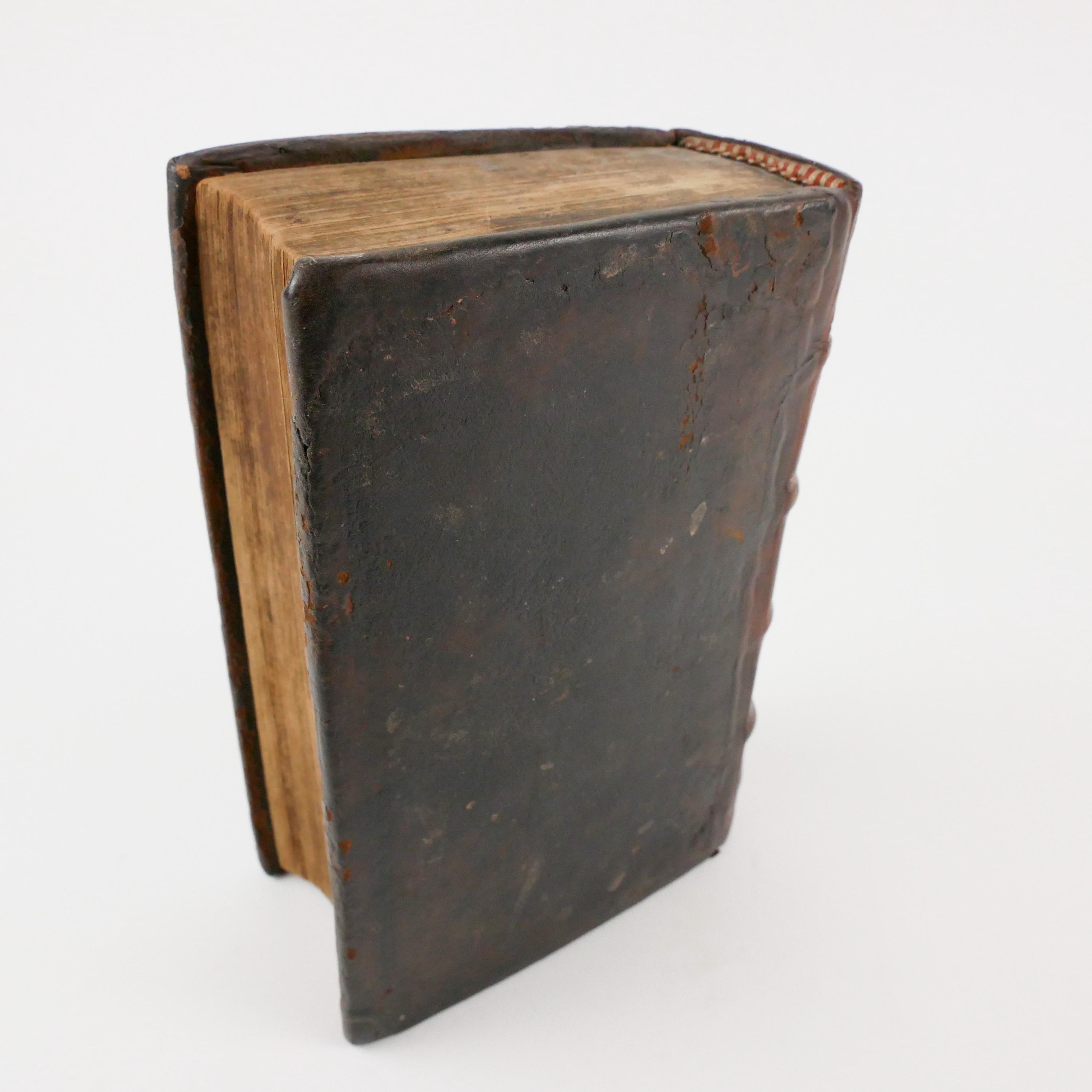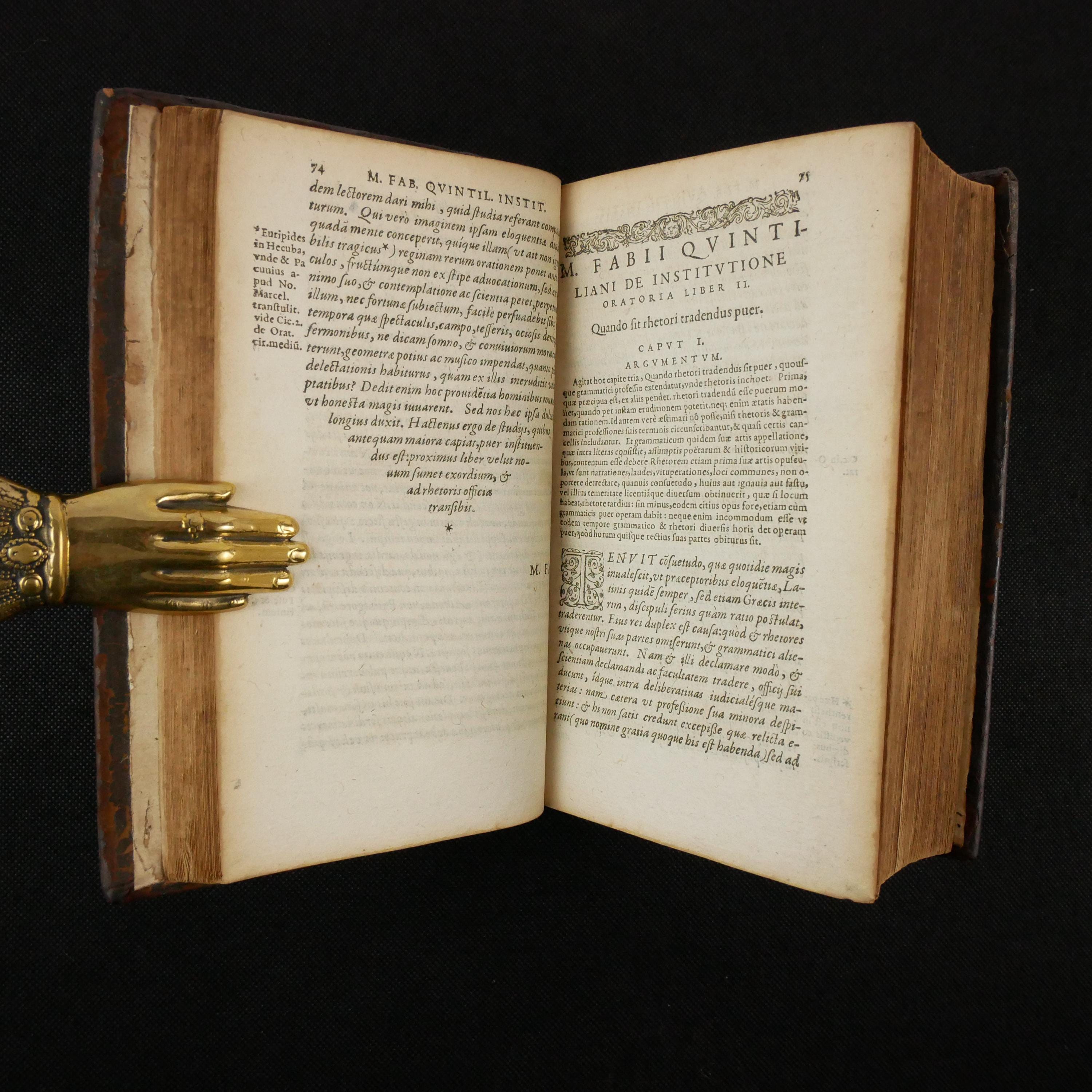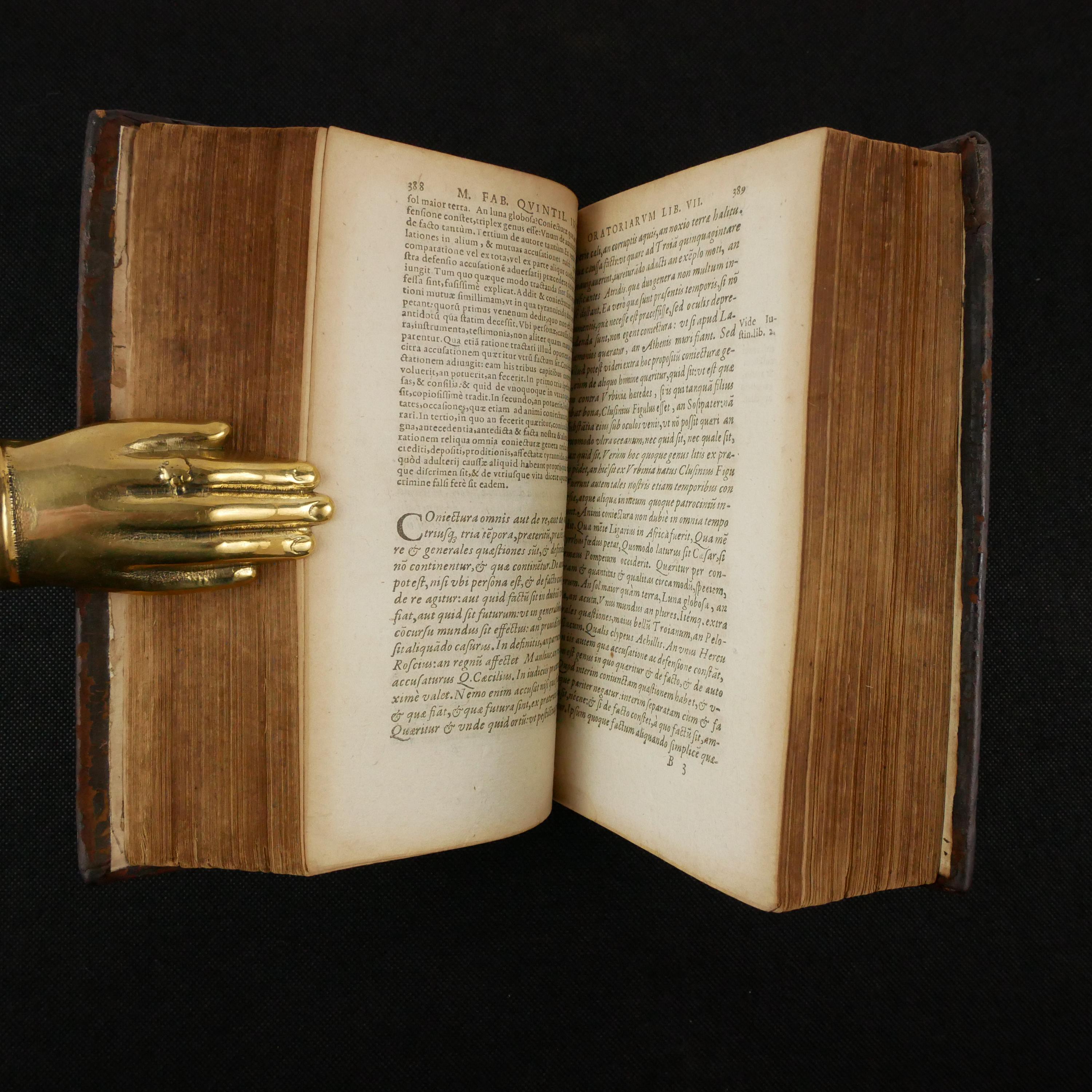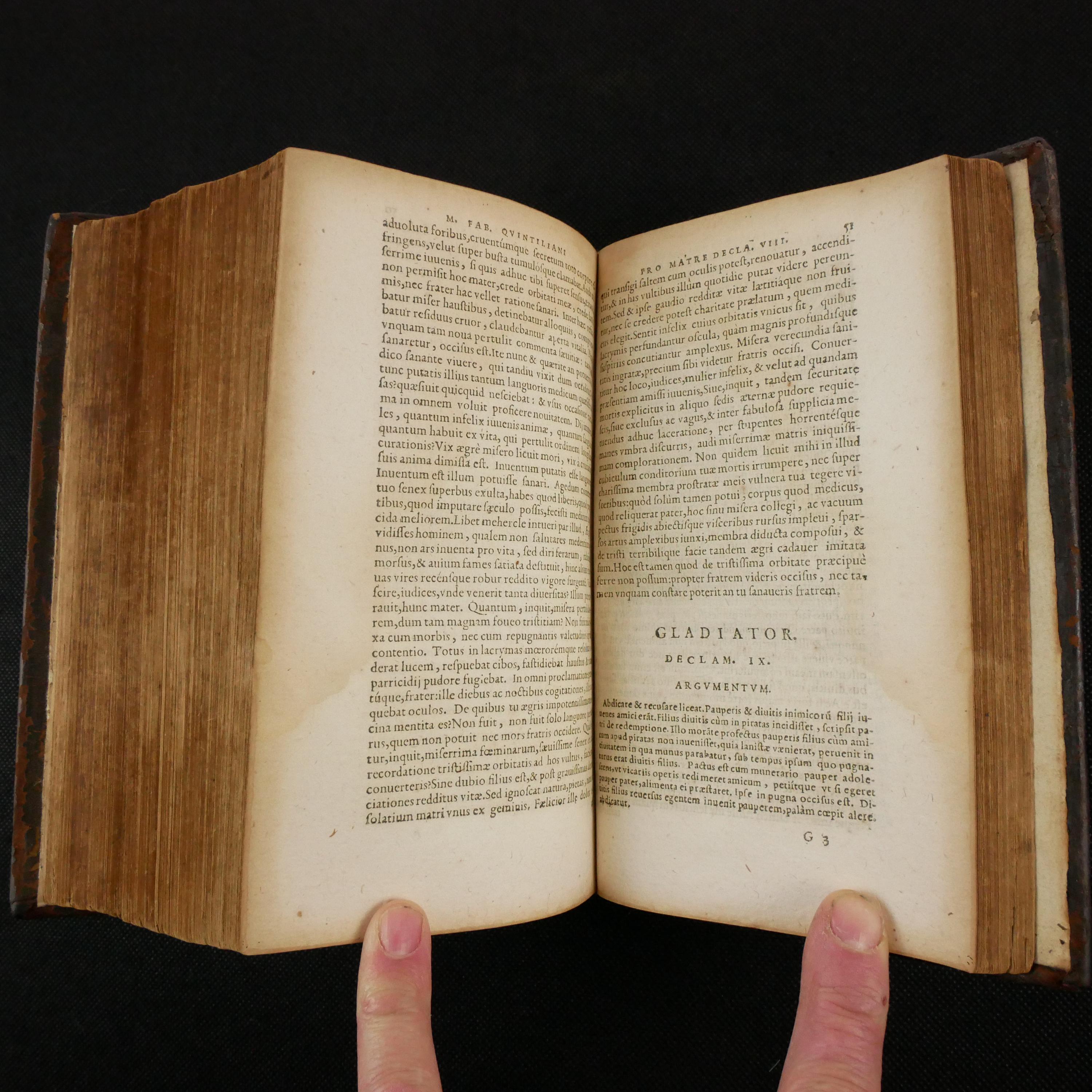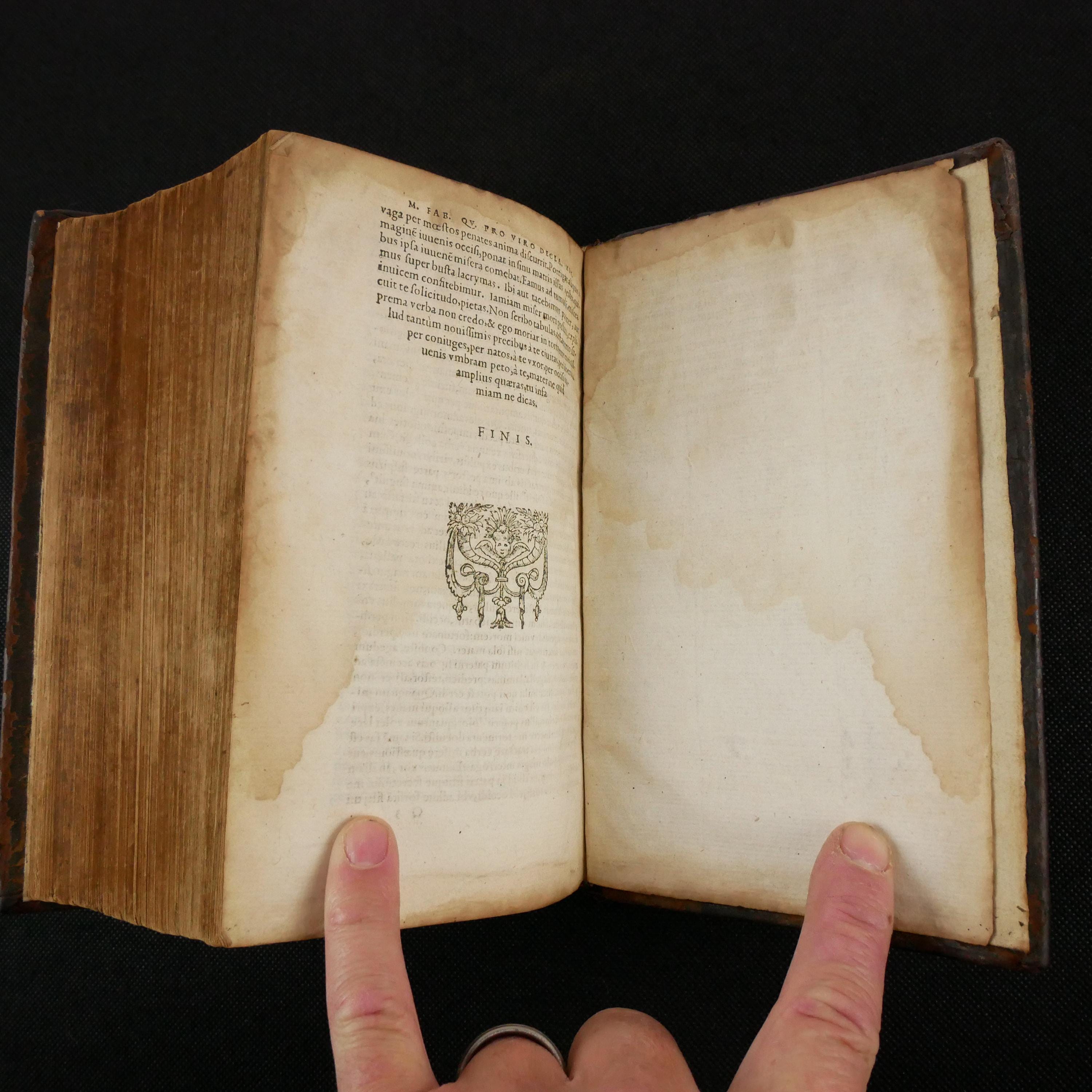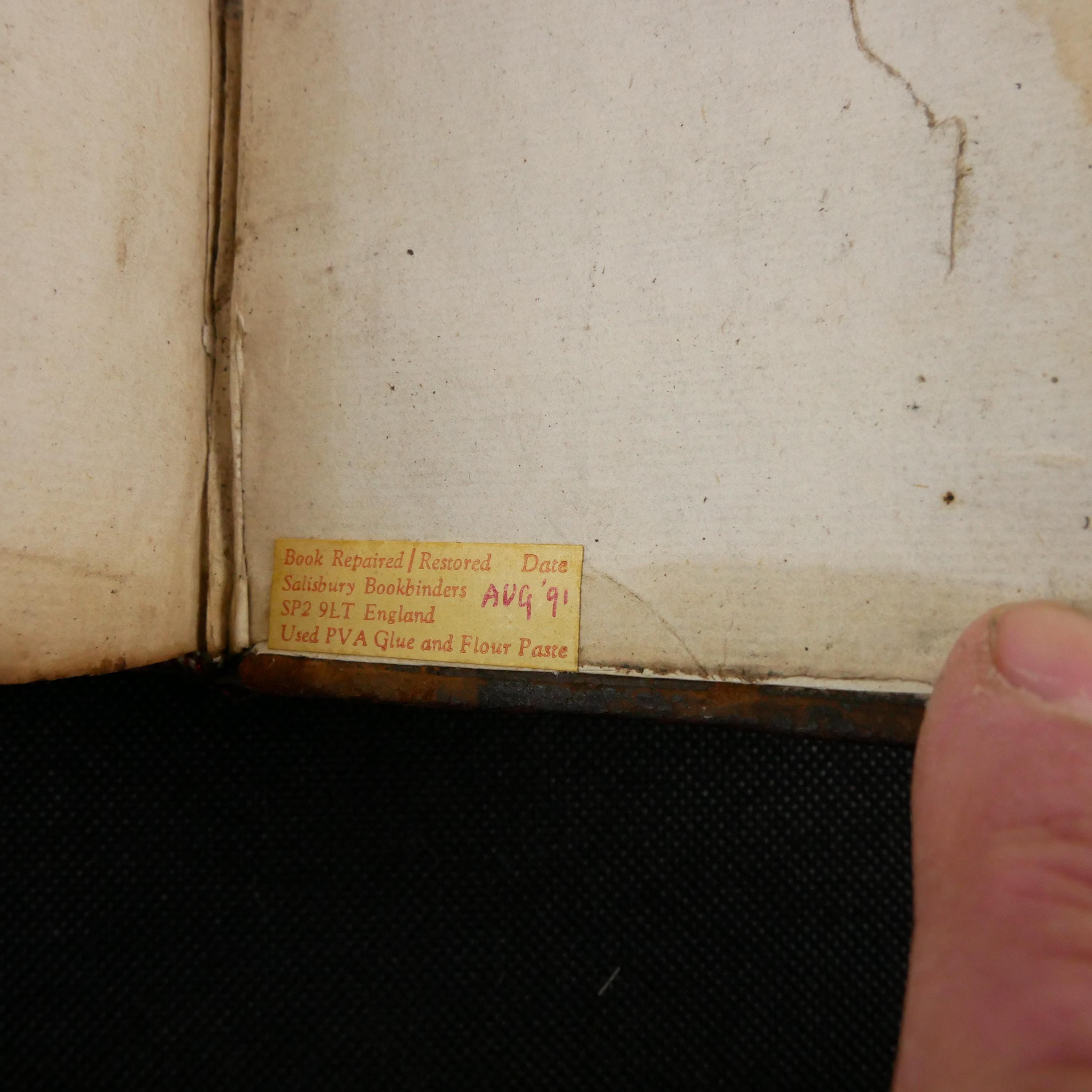1591 M. Fabii Quintiliani (Quintilian) Institutionum Oratoriarum. Stoer, Geneva
$649.99
Quintilian's classic work on rhetoric, Institutions of Oratory (this edition in Latin), with the often associated (but, likely, erroneously attributed) Declamations bound in at the rear. Quintilian, a Roman of Spanish origin, here describes the art of rhetoric and presents his opinions on the teaching and training necessary to be successful. This work was used extensively in the education of renaissance Europe.
Description of the Literature-
Institutio Oratoria (English: Institutes of Oratory) is a twelve book work on the theory and practice of rhetoric. It was published around year 95 CE. The work deals also with the foundational education and development of the orator himself.
Quintilian published Institutio Oratoria in the last years of Domitian’s rule of the empire. He had worked along Domitian’s side, but as he began to write more and ease away from Emperor Domitian’s complete power, the emperor did not seem to mind as he was so impressed with Quintilian, he hired him to be a tutor for his family because of Quintilian’s devotion to education. Domitius was at the harshest part of his rule, and near no one had the courage to speak any idea that was unlike his, but Quintilian did. He spoke as an orator in the tradition of Cicero, which had not been seen since the beginning of the ruling of Augustus. Rather than pleading cases like all 95 C.E. orators, he decided to take a more passive route to speak on how a sound rhetoric influences the education of the common.
In addition, there is a second part containing the Declamations. However, there is some dispute over the real writer of these texts: "Some modern scholars believe that the Declamations circulated in his name represent the lecture notes of a scholar either using Quintilian's system or actually trained by him".
About Quintilian -
Quintilian (Marcus Fabius Quintilianus) was a prominent orator and teacher of rhetoric in Rome during the Flavian period. His best-known work is the Institutio Oratoria, “The Orator’s Education,” which presents an idealized curriculum for the training of orators, beginning with their birth and extending through their retirement in old age. It has been treated primarily as a storehouse of information about ancient rhetorical theory and Roman educational practices but is increasingly recognized as a literary work in its own right, marked in particular by Quintilian’s own deployment of the same rhetorical techniques that the Institutio teaches. – Oxford Classical Dictionary
The Middle Ages saw a decline in knowledge of his work, since existing manuscripts of Institutio Oratoria were fragmented, but the Italian humanists revived interest in the work after the discovery by Poggio Bracciolini in 1416 of a forgotten, complete manuscript in the Abbey of Saint Gall, which he found "buried in rubbish and dust" in a filthy dungeon. The influential scholar Leonardo Bruni, considered the first modern historian, greeted the news by writing to his friend Poggio:
It will be your glory to restore to the present age, by your labour and diligence, the writings of excellent authors, which have hitherto escaped the researches of the learned... Oh! what a valuable acquisition! What an unexpected pleasure! Shall I then behold Quintilian whole and entire, who, even in his imperfect state, was so rich a source of delight?... But Quintilian is so consummate a master of rhetoric and oratory, that when, after having delivered him from his long imprisonment in the dungeons of the barbarians, you transmit him to this country, all the nations of Italy ought to assemble to bid him welcome... Quintilian, an author whose works I will not hesitate to affirm, are more an object of desire to the learned than any others, excepting only Cicero's dissertation De Republica.
About the Printer -
Jacob Stoer (1542-1610) was born in Otlingen, near Strasbourg. He travelled to Geneva at the age of 17 to apprentice himself to master printer Jean Crespin. This association introduced him to prominent Reformers such as Jean Calvin and Theodore Beza. He had achieved the status of master printer by 1563, and became a citizen of Geneva in 1568, which permitted him to open his own workshop. He printed chiefly juridical, medical, controversial religious and political works. In addition to printing, Stoer also produced original editions of a number of writings including bilingual editions of religious texts (French and German), editions of ancient Greek and Latin authors, and several dictionaries, including this one. Between 1571 and his death in 1610, he printed 368 titles. His printing shop continued operation under his son and grandson.
Bibliographic Details -
Universal Short Title Catalogue (USTC) number 451289, found in 30 of the world's libraries. Interestingly, no U.S. copies are listed.
Gilmont, in his work Les Editions Imprimees a Geneve, lists this book as 3493
Physical Attributes -
Measures approx. 18 x 11 x 6 cm. Leather binding, respined. Original boards with the faintest trace of a blind fillet border. Spine with four raised bands, one compartment with the title in gilt on red morocco. Red and white endbands. Restored endpapers. Two title pages (one for each part) with decorative borders.
Pages - part 1, xvi, 734, [64], 1 blank leaf, part 2,107, blank leaf.
Collation - part 1, *8, a-z8, A-Z8, Aa-Dd8, part 2, A-N8, O4
Condition -
See pictures. Respined, the original boards were quite worn, rubbed etc. and personally I don't see much purpose in why they were retained, but on the positive side you likely have contemporary leather. Some damage to front pastedown, presumably original and relaid as there's another good one under it. 1923 bookseller note to flyleaf. Text block toned with occasional fox spots throughout. Occasional moisture marks at the edges throughout. Some thumbing, dog-eared pages, candle ember marks, etc. Title page with "51" in an old hand. At rear, moisture mark is larger and intrudes into text. Bookseller ticket at rear stating it was repaired in 1991 using PVA glue and flour paste.
Shipping from United States
Processing time
1-3 business days
Customs and import taxes
Buyers are responsible for any customs and import taxes that may apply. I'm not responsible for delays due to customs.
Payment Options
Returns & Exchanges
I gladly accept returns
Just contact me within: 7 days of delivery
Ship items back to me within: 14 days of delivery
I don't accept exchanges or cancellations
But please contact me if you have any problems with your order.
Conditions of return
Buyers are responsible for return shipping costs. If the item is not returned in its original condition, the buyer is responsible for any loss in value.
Privacy policy
We do not collect any private information. For billing, Etsy provides the service. We only receive notice that payment was made. The shipping address is provided to us by Etsy, based on what they buyer submitted during check-out. We do not store these addresses. That is the extent of the information that we receive during a transaction.

